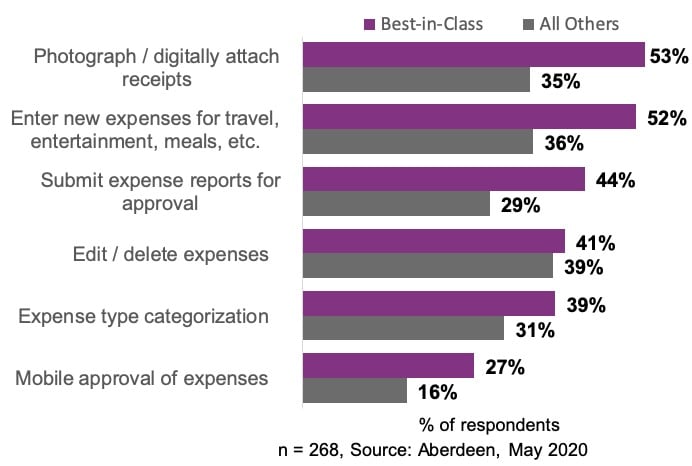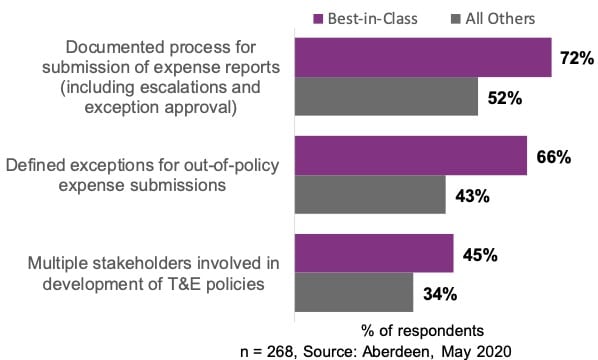T&E Management: The Road to Recovery, Part 2
During a recent Aberdeen webinar, analyst Bryan Ball shared that, “Mobile is back!” and “Return to travel will be robust!”
Mobility will be key on the road to recovery as many employees continue to work from home. According to Ball, travel will be robust once it returns, so it is important to make adjustments to policies. More importantly though, companies need to determine how quickly they can incorporate policy changes into their spend workflows and processes in place. In this second part of our blog series, we take a closer look at the path to recovery and the methods and tools businesses are taking advantage of.
Why mobile expense management matters now?
The effect that mobility has had on expense reporting is astonishing. In just a short amount of time, the move to a more mobile business world has vastly improved the visibility into spending processes, the speed of reporting, and the accuracy. The pandemic is pushing more companies to evaluate their expense software to ensure these capabilities are in place to improve the employee experience.
Here are some key benefits of having dynamic remote capabilities:
- Entering expenses from a mobile device provides earlier visibility to expenses
- The ability to capture receipts at the source and enter into a report cuts days off reporting time
- Entering expense reports from a mobile device provides earlier visibility to expenses and cash flow
- Remote submission for approval saves time for the employee as well for reimbursement
- Including categorisation options makes reporting analysis much faster
- Mobile approval also eliminates wasted time
Here are some tips and tricks that best-in-class (top 20%) companies are using to take full advantage of the mobile world.
- Photograph and digitally attach receipts. T&E processes and reporting should be consistent with the quality and simplicity that employees are accustomed to in the consumer world. Best-in-class companies use this service to rise above the rest, as 53% do this compared to only 35% of all other companies.
- Enter expenses right away for things like travel and entertainment. Reduce reporting times by days by entering expenses when they happen. Additionally, there is earlier visibility to cash flow and expenses. Fifty-two percent of best-in-class companies enter expenses on mobile compared to only 36% of all other companies.
- Submit, edit, and delete expense reports from mobile devices. This convenience saves employees time and reduces time to reimbursement. Fourty-four percent of best-in-class companies submit expense reports on mobile compared to only 29% of all other companies.
- Categorize all your expenses with ease. By including categorisation options, expense reporting is much quicker and allows for better analysis. Thirty-nine percent of best-in-class companies utilize mobile categorization to save time, compared to 31% of all other companies.
- Approve expenses right away. The ability to approve expenses on mobile cuts down on wasted time and allows you to focus your attention on high-value tasks. Mobile approval is seen in 27% of best-in-class, companies compared to 16% of all other companies.
The best part about these practices is that the benefits are not only applicable to T&E management. According to Jeanne Dion, senior value consultant for SAP Concur, “digital attachments, the ability to submit and approve in mobile apps, and using application configuration to drive compliance and governance is also important for invoice processing solutions, for more visibility into spend, and increased cash flow management." She also mentions that this type of mobility and convenience is a “game-changer” and will become a big deal on the vendor invoice side.

How to make your expense management policies resilient
T&E masters need to quickly adapt policies in response to direction they are getting from internal business continuity teams which is fluid. Ball explained during the webinar that strong policies are the backbone for expense management.
"You need to make it easy for employees to comply," said Dion. "Your T&E tool can do this. We've spent countless hours with clients, figuring out how to get creative with their configuration and workflows to meet their business needs while making it easy for their employees to do the right thing the first time."
Here are some policy tips discussed:
- Compliance improves visibility by driving more spend through standard processes
- Best-in-class companies are much more likely to have a well-documented process in place. Good policies contribute to higher compliance rates.
- A well-defined out-of-policy exception process eliminates a lot of manual approvals that cause approval delays and require unnecessary management attention.
- Part of the homework by the best-in-class policymaking is accomplished by having cross-functional stakeholders involved in the process.
Human resources, tax, compliance, audit, legal, purchasing, security, and others should be influencing decisions around an enterprise company’s T&E policy and processes. “These departments are realising the value of T&E as not just a way to control costs, but as a way to gain better compliance in all areas of the business to limit its enterprise risks,” says Dion.

The bottom line
Having solutions in place to leverage mobile capabilities, and policies in place to accommodate employees, will give your company the best foundation for recovery. The benefits are clear when looking at the KPIs and how best-in-class companies are performing as they take advantage of these solutions:
- 44% ROI after implementation
- 36% Year-over-year savings
- 57% of VAT-compliant T&E expenses
- 64% of travel expenses are on or below budget
For more insight on the road to recovery and growth when it comes to T&E management, listen to this Aberdeen webinar. Then watch for the third part of our blog series. Read part one if you missed it!